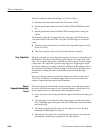
Theory of Operation
2715 Spectrum Analyzer Service Manual
3-85
5. Steps 2 and 4 are repeated, retriggering either the POS or ROS, until the
switch has stabilized in the closed position.
6. Each single shot then times out approximately 50 ms after the last valid
trigger.
7. Now the switch is released and a negative edge is presented to both the POS
and the ROS.
8. This edge triggers the ROS and its output becomes active.
9. With the ROS output active and POS output inactive, the POS is held in the
reset state by a NAND gate.
10. The ROS is retriggered, by each falling edge of the bouncing switch, until
the switch has stabilized in the open state.
11. After approximately 50 ms, the ROS times out and its output becomes
inactive.
12. The POS and the ROS are ready for another key press.
Figure 3--27 shows the three possible scenarios of key presses and how the
debounce circuit reacts to each one.
(a) (b) (c)
POS
ROS
KEY INKEY IN
POS
ROS
NOTE: The dotted lines denote retrigger points relative to the KEY IN pulse transitions.
KEY IN
POS
ROS
Figure 3- 27: How the Debounce Circuit Reacts to Key Closure


















